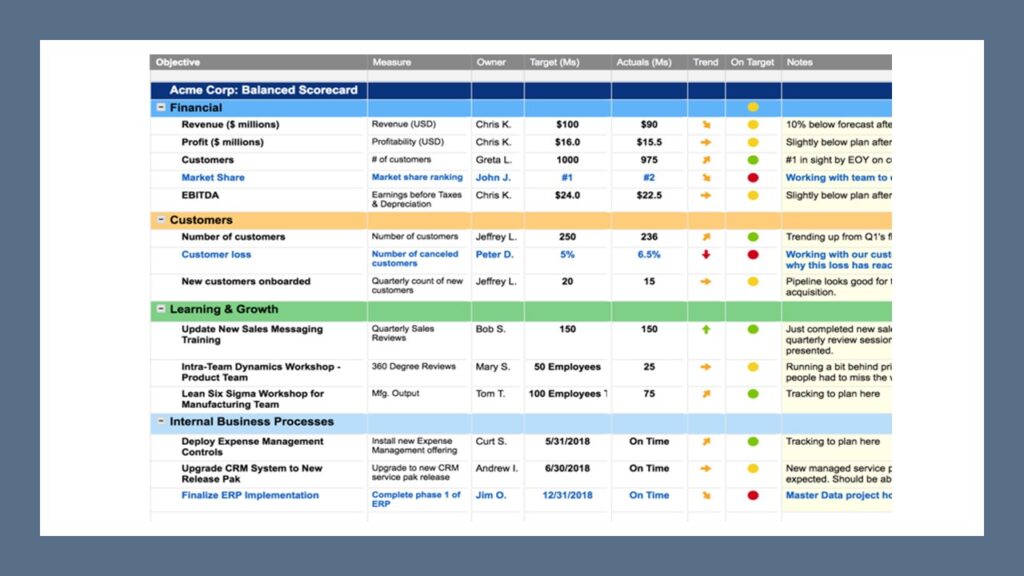
I love Warren Buffet’s quote “If you don’t know the score, you can’t tell the winners from the losers.” We all know to watch the scoreboard at a basketball game to see which team is winning. Like sports, a Business Scorecard has become a popular tool to track activities and performance throughout organizations.
Traditionally, Business Scorecards have primarily relied on financial information to tell the story behind the performance of a business. The problem is by the time financial results are published it’s too late to do anything for that period of time to change the outcome. Business Scorecards should include activity-based metrics that are leading indicators that can be used proactively to avoid big problems.
The Balanced Scorecard
In recent years the concept of a “Balanced Scorecard” has become popular. The Balanced Scorecard Institute provides the following description: “The name ‘Balanced Scorecard’ comes from the idea of looking at strategic measures in addition to traditional financial measures to get a more ‘balanced’ view of performance. The concept of a Balanced Scorecard has evolved beyond the simple use of perspectives, and it is now a holistic system for managing strategy.”
Using scorecards provides a way for organizations to connect the dots between strategy, planning and execution, meaning a connection between the projects and programs that people are working on, the measurements used to track progress and the goals for the business.
Let’s examine the following sample Balanced Scorecard for Acme Corporation:

This example begins with Acme’s objectives, measure, owner, targets, actuals, trends, on-target traffic lights (green, yellow and red) and a place for comments. Acme’s scorecard has four primary elements that tie back to the organization’s objectives: Financial Results, Customers, Learning & Growth and Internal Business Processes. Some of these use quantitative measurements while others use qualitative metrics, such as a due date.
Every organization should develop a unique scorecard that best meets its needs. Don’t start with too many elements. It’s better to start with a handful of metrics (KPIs) to track progress. You can always add more for either the overall company performance or departmental and even team performance. The key is to use your scorecard regularly to spot trends and raise red flags when performance is not going as planned. I have many clients start with the following six basic metrics:
- Leads
- Proposals
- New Sales
- Backlog (Signed Contracts Not Delivered)
- Gross Profit
- Available Cash
These provide leading indicators for future business performance. For example, if leads or the sales pipeline looks low, odds are future sales will suffer.
Everybody Needs a Number
Last, every employee should have at least one metric that they track to manage their performance. Even at lower levels of the organization, it’s good to have employees aligned with the business objectives. For example, a shipping clerk can measure on-time shipments, or a customer service associate can be tracked against customer satisfaction tied to first contact resolution. Don’t pick an arbitrary measurement for employees. Tie the metric to their activities towards achieving company goals. This will be more relevant and align the employee activity to the business goals.
In my previous CFO role for a mobility dealership, I tracked three critical numbers first thing every morning to give me an indication of what was going on within the business. I called these my “Big 3”:
- Available Cash on Hand
- Unit Sales from the Previous Day
- Inventory Available for Sale at Each Location
These metrics alerted me to act if something didn’t look right. For example, if we sold a large number of units, did we have enough inventory to accommodate future client demand? Did we need to transfer inventory from another location or purchase new units to meet demand? Did we have enough cash on hand to meet future requirements such as fund payroll at the end of the week?
Your Business Scorecard is an important tool to track progress, identify issues before they become big problems and drive accountability throughout your organization. Make sure you keep score to ensure your business is on track.
